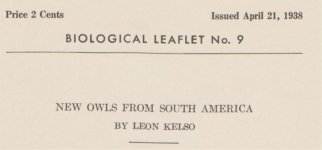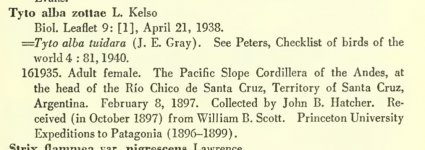Taphrospilus
Well-known member
Not really much more than in The Eponym Dictionary of Birds on Tyto alba zottae . I havent's seen OD in
Kelso, Leon Hugh, Two New Owls from South America Biological Leaflet, no. 9
His obituary here p. 104
Anyone here knows his middle name and when he was born in Italy?
Kelso, Leon Hugh, Two New Owls from South America Biological Leaflet, no. 9
His obituary here p. 104
Ángel Zotta el 25 de mayo de 1951 en esta capital. Con la desaparición de don Ángel Zotta ha perdido el Museo Argentino de Ciencias Naturales y nuestra Asociación, a una de sus figuras más laboriosas y bien dispuestas. Nacido en Italia había llegado al país a muy temprana edad y casi simultáneamente se empleó en el entonces Museo Nacional de Buenos Aires, durante la dirección del doctor Berg. Paralelamente a las funciones que desempeñaba en la sección Ornitología — Conservador y destacado taxidermista— realizó tareas en la sección Entomología. El Hornero recogió en sus páginas, en diversas oportunidades, sus interesantes observaciones y trabajos.
Anyone here knows his middle name and when he was born in Italy?
Last edited:







